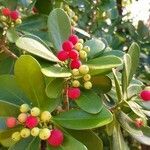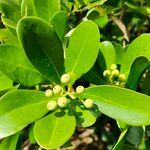Leaf blade 5-15 × 2-5cm, apex rounded or blunt; abaxial surface pellucid-dotted. Flowers ca. 7 mm diam., pedicel short; sepals green, 2-3 mm, fleshy; petals deep red to magenta, basally light red to yellow, 4.5-6 mm, thick and fleshy; anthers light red, becoming yellow at anthesis; stigma yellow. Seeds 1-5, black. 2 n =28. [P. Goldblatt 1976]



